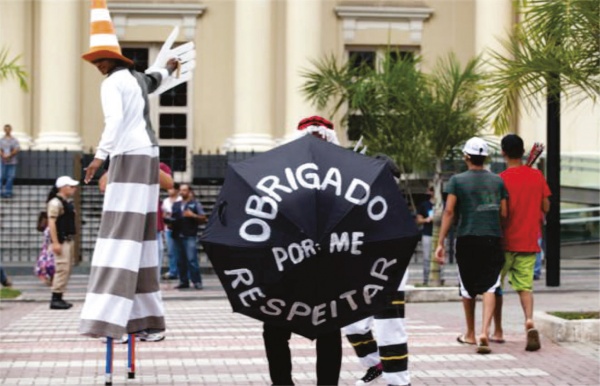Life in Traffic: An Intersectoral Strategy
In 2010 the Ministry of Health, with support from PAHO/WHO, launched the Life in Transit initiative in five Brazilian cities. This national initiative promotes health and a culture of peace on public roadways through training and awareness seminars and specific activities to prevent road traffic injuries and deaths. It created opportunities for intersectoral collaboration and coordination. In Belo Horizonte, the program delivered three workshops with relevant stakeholders to review the data and develop, adopt and implement an Action Plan. Life in Transit involved federal, state and municipal governments, coordinated joint actions, and prioritized collaborative efforts to identify risk factors for road traffic injuries. Based on the findings, the initiative created working groups for specific population sectors like young drivers, passengers, and pedestrians, and to study factors such as alcohol and driving, and speed.
Meets the criteria established under Health in All Policies:
- Political commitment. Life in Transit enjoys political commitment at the highest levels. The Ministry of Health supports the initiative at the national and local levels, as does the Belo Horizonte, Minas Gerais Transit Company (BHTRANS).
- Separate structure. A National Committee on Mobilization for Health, Safety and Peace on Public Roadways coordinates the Life in Transit strategy. Comprised of the Ministries of Health, Cities (Urban development), Justice, Transportation, and Education, the National Committee is responsible for conducting assessments that promote joint, cross-sector road safety strategies. A local inter-institutional commission includes representatives from the Health and Education Secretariats, BHTRANS, DETRAN, the Municipal Guard, and the Municipal Council on health, among others. As a complement to the work of the National Committee, the Intersectoral Commission for Control and Prevention of Traffic Accidents was created in 2004 with representatives of the executive branch, universities, and civil society, among others.
- Participation of other sectors. Other sectors along with health participate in Life in Transit. At the municipal level, the initiative offers learning activities in public schools and includes driver education in school curricula. The Municipal Guard is responsible for traffic operations and control. The state Social Defense Secretariat designs public education campaigns on alcohol consumption. The Transit Department of Minas Gerais maintains a database on road traffic collisions and examines risk factors. The military police of Minas Gerais is a member of the local inter-institutional commission and, with BHTRANS, conducts data management and monitoring. PAHO/WHO provides advisory services to the Ministry of Health and the local government, while international NGOs offer consulting services and financial support. Some of the main unions offer political backing and are involved in coordinating the initiative.
- Separate budget. Although it lacks its own funding, Life in Transit receives financial support from the municipal health secretariat and BHTRANS. All of the participating institutions allocate a portion of their budget to this initiative.
- Intersectoral action. The initiative reflects effective intersectoral action, particularly in generating data on road traffic collisions and in joint planning of activities to reduce road traffic mortality.
- Public policy. Life in Transit contributes to public policies that impact health. For example, as a result of this initiative, school curriculums have been adapted to include training and awareness activities on the use of public roadways in order to prevent road traffic collisions and promote a culture of peace.
- Evidence of results. There is scientific evidence of the results of Life in Transit. The initiative monitors risk factors and at-risk groups on a quarterly basis and its internal evaluations are used as the basis for adapting activities and programs. The Federal University of Minas Gerais and Johns Hopkins University have performed external evaluations. The BHTRANS database feeds the Mortality Information System and hospitalization registries in the Single Health System. These data show that the mortality declined from 2.36 to 1.52 per 10,000 vehicles between 2009 and 2011, while the number of road traffic collisions dropped from 3,076 to 2,852 in that same period.
- Social participation. This is ensured through the local councils and municipal health forums and is reflected in local action plans.
